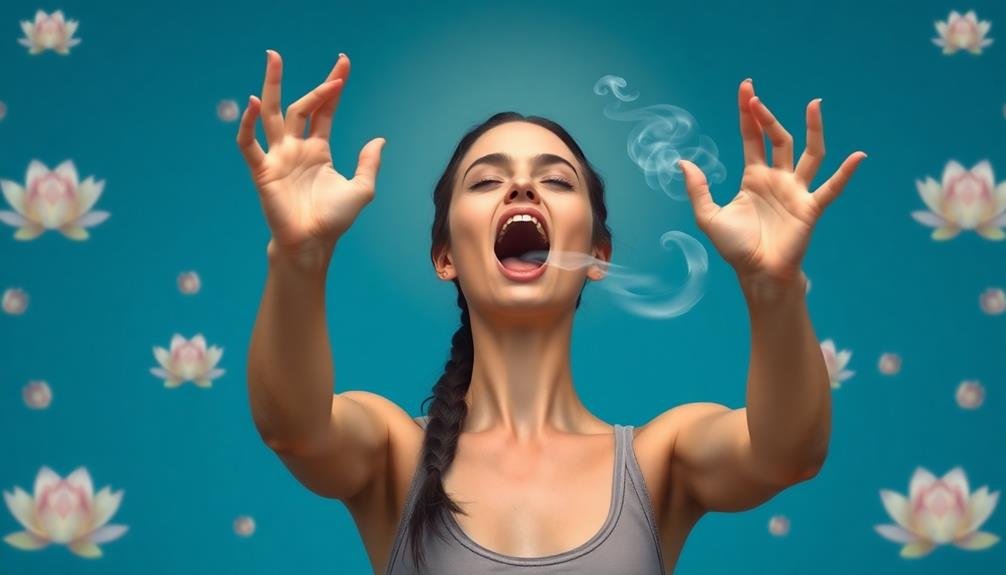Three powerful yoga breathing techniques can help ease your anxious mind. Alternate Nostril Breathing, or Nadi Shodhana, balances your mind and body by alternating breath between nostrils. Deep Belly Breathing engages your diaphragm, promoting relaxation and reducing stress. The Lion's Breath Technique invigorates your body and mind through forceful exhalation and facial muscle engagement. Each technique offers unique benefits, from calming your nervous system to boosting confidence and releasing emotions. Practice these for 5-10 minutes daily to restore inner harmony and combat anxiety. Discover how these ancient techniques can transform your mental state and bring lasting peace.
Key Takeaways
- Alternate Nostril Breathing balances the mind and body, reducing stress levels in just 5-10 minutes daily.
- Deep Belly Breathing engages the diaphragm, promoting relaxation and lowering blood pressure through efficient oxygen flow.
- Lion's Breath Technique invigorates the body and mind, releasing tension and boosting confidence in 3-5 rounds.
- These techniques calm the nervous system, making them effective tools for managing anxiety and overwhelming emotions.
- Regular practice of these breathing exercises can restore harmony and ease anxious minds in as little as 5-10 minutes per day.
Alternate Nostril Breathing

Alternate nostril breathing, or Nadi Shodhana, is one of the most effective yoga breathing techniques for balancing the mind and body. This practice involves alternating your breath between the left and right nostrils, which can help calm your nervous system and reduce stress.
To begin, sit comfortably with your spine straight. Place your left hand on your left knee and raise your right hand to your nose. Use your right thumb to close your right nostril and inhale deeply through your left nostril. At the top of your inhalation, close your left nostril with your ring finger and release your thumb to exhale through the right nostril.
Inhale through the right nostril, then close it with your thumb and exhale through the left. This completes one round.
Continue this pattern for 5-10 minutes, focusing on your breath and letting go of any distracting thoughts. You'll likely notice a sense of calm and balance settling over you.
Practice alternate nostril breathing daily, especially when you're feeling anxious or overwhelmed, to restore harmony to your mind and body.
Deep Belly Breathing

Deep belly breathing, also known as diaphragmatic breathing, offers a different approach to calming the mind and body. This technique focuses on engaging your diaphragm, the muscle at the base of your lungs, to promote deeper, more efficient breaths.
To practice deep belly breathing, lie on your back with one hand on your chest and the other on your belly. Breathe in slowly through your nose, allowing your belly to rise while keeping your chest relatively still. As you exhale through your mouth, feel your belly lower. You're aiming to breathe deeply into your abdomen, not shallowly into your chest.
Start with 5-10 minutes of deep belly breathing daily. As you become more comfortable, you can practice while sitting or standing.
This technique helps reduce stress, lower blood pressure, and improve oxygen flow throughout your body. It's particularly effective when you're feeling anxious or overwhelmed.
Lion's Breath Technique

While it may seem unconventional, the Lion's Breath technique is a powerful yogic practice that can invigorate your body and mind. This dynamic breathing exercise involves exhaling forcefully while making a "roaring" sound, mimicking a lion's roar.
You'll also engage your facial muscles, creating a unique expression that helps release tension and stress.
To perform Lion's Breath:
- Sit comfortably on your heels or in a cross-legged position
- Place your hands on your knees, spreading your fingers wide
- Inhale deeply through your nose, then open your mouth wide and stick out your tongue
As you exhale, make a "ha" sound from the back of your throat, engaging your diaphragm and abdominal muscles. Simultaneously, open your eyes wide and focus your gaze upward or at the space between your eyebrows.
This technique can help alleviate anxiety, improve circulation, and stimulate your throat chakra.
Practice Lion's Breath for 3-5 rounds, taking normal breaths between each repetition. You'll likely feel energized and refreshed afterward.
It's an excellent way to combat fatigue, boost confidence, and release pent-up emotions.
Frequently Asked Questions
How Often Should I Practice Yoga Breathing Techniques for Optimal Anxiety Relief?
You should practice breathing techniques daily for ideal anxiety relief. Start with 5-10 minutes and gradually increase to 15-20 minutes. Consistency is key, so try to incorporate these exercises into your regular routine for best results.
Can Yoga Breathing Exercises Be Harmful if Done Incorrectly?
Yes, incorrect yoga breathing can be harmful. You're risking hyperventilation, dizziness, or increased anxiety if you don't follow proper techniques. It's essential you learn from a qualified instructor and listen to your body's signals while practicing.
Are There Any Age Restrictions for Practicing These Breathing Techniques?
You'll find most breathing techniques are safe for all ages. However, you should supervise children and consult a doctor if you're elderly or have health issues. Always listen to your body and stop if you feel discomfort.
How Long Does It Take to See Results From Regular Yoga Breathing Practice?
You'll likely notice some immediate benefits from regular breathing practice. However, consistent practice over 4-8 weeks can lead to significant improvements in your stress levels and overall well-being. Stick with it, and you'll see results.
Can Yoga Breathing Techniques Replace Medication for Anxiety Disorders?
While yoga breathing can greatly reduce anxiety, it shouldn't replace prescribed medication for anxiety disorders. You'll need to consult your doctor before making changes. It's often most effective when used alongside traditional treatments, not as a replacement.
In Summary
You've now learned three powerful yoga breathing techniques to calm your anxious mind. Whether you choose alternate nostril breathing, deep belly breathing, or the lion's breath technique, you'll find a method that works for you. Remember, these practices are most effective when done regularly. Don't wait for anxiety to strike; incorporate these techniques into your daily routine. With consistent practice, you'll build resilience and find greater peace of mind. Give yourself the gift of breath and embrace a calmer you.





Leave a Reply